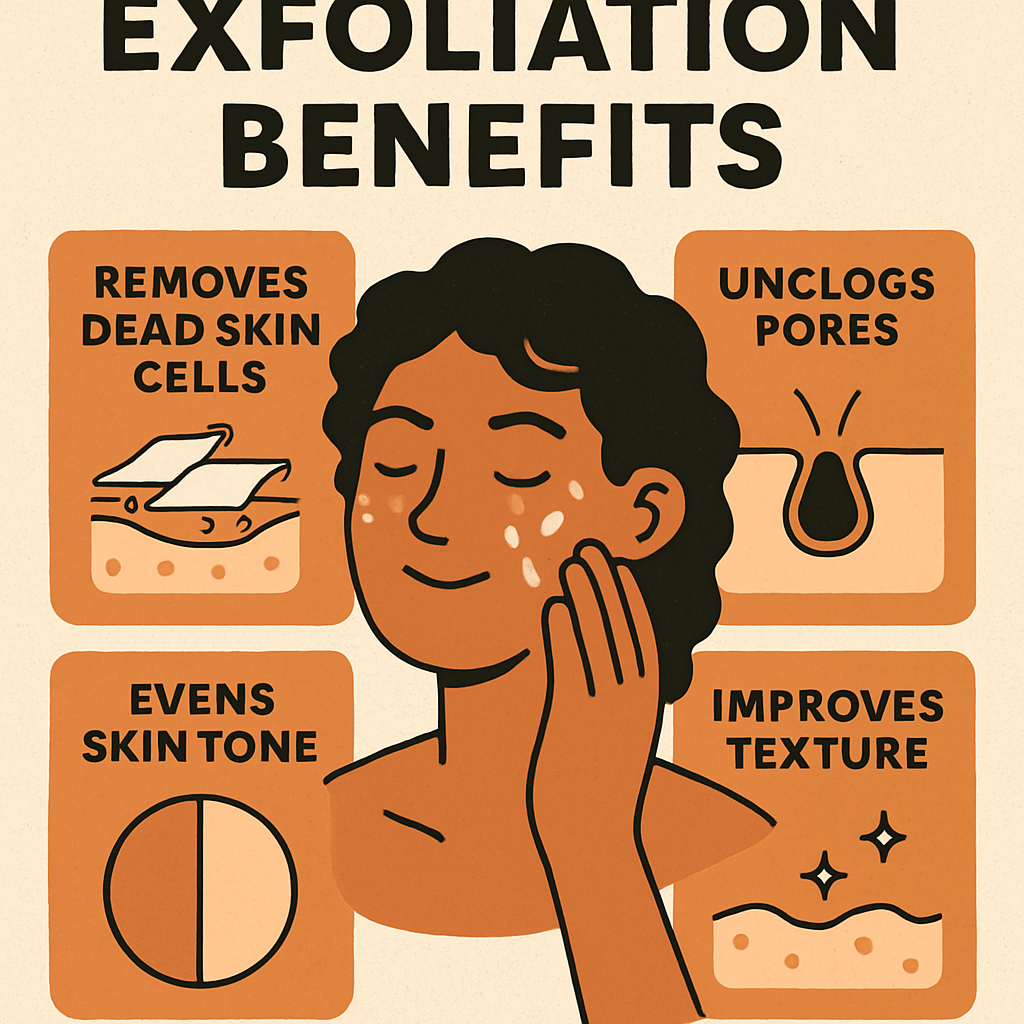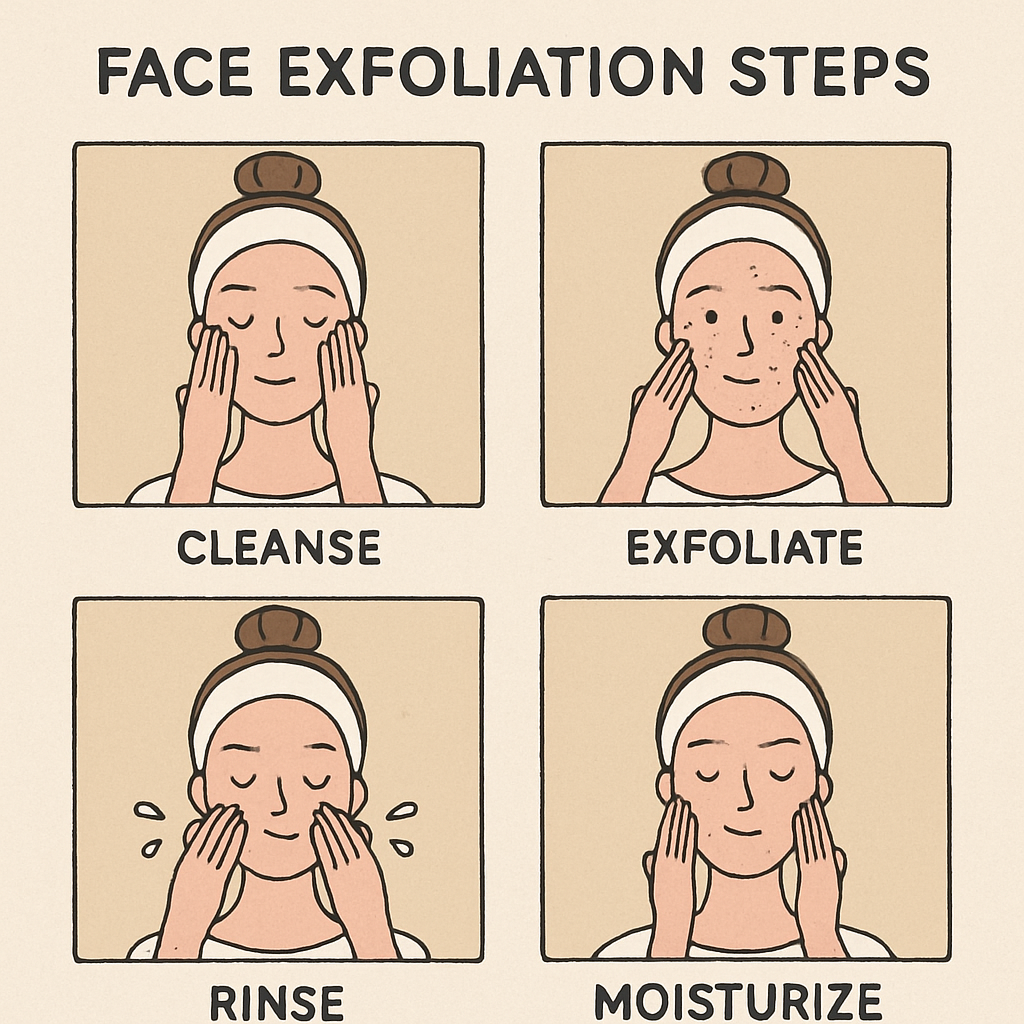Essential Tips for Effective Facial Exfoliation
Share
Exfoliating your face is a crucial step in maintaining healthy, glowing skin. The process involves removing dead skin cells, unclogging pores, and it can even improve your skin's texture and tone. When done correctly, exfoliation can transform your skincare routine by enhancing the effectiveness of other products you use. Whether you're a skincare novice or a seasoned pro, understanding how to exfoliate properly is essential. In this guide, we will explore the best face scrubs, how to exfoliate your face, and tips specifically for men, ensuring you make the most out of this vital skincare step.

Benefits of Regular Exfoliation
- Improves Skin Texture: Regular exfoliation can smooth out rough patches and give your skin a more even appearance. This can be particularly beneficial for those with uneven skin tone or texture issues. Over time, consistent exfoliation may also help reduce the appearance of fine lines and wrinkles, contributing to a more youthful look.
- Unclogs Pores: By clearing out dead skin cells and debris, exfoliation helps prevent blackheads and breakouts. This is crucial for maintaining clear skin, especially for individuals with acne-prone skin. Exfoliation can also minimize the appearance of pores, giving your skin a smoother and more refined look.
- Enhances Absorption: With clear, fresh skin, your serums and moisturizers can work more effectively. The removal of dead skin cells allows active ingredients in your skincare products to penetrate more deeply, maximizing their benefits. This means that your entire skincare regimen becomes more efficient, potentially leading to faster and better results.
- Boosts Circulation: Exfoliating promotes blood circulation, which can give your skin a healthy glow. Improved blood flow not only brings more nutrients to the skin but also aids in the removal of toxins. This can enhance your skin's overall appearance and vitality, making it look more radiant and energized.
Choosing the Best Face Scrubs
When it comes to selecting the right exfoliator, it's important to consider your skin type and any specific concerns you may have. Not all exfoliators are created equal, and using the wrong one can do more harm than good. Understanding the different types of exfoliators and their benefits can help you make an informed decision.
Types of Exfoliators
- Physical Exfoliators: These contain small particles or granules that physically scrub away dead skin cells. Examples include scrubs made with sugar, salt, or microbeads. Physical exfoliators can be very effective but should be used with caution to avoid over-exfoliation or irritation, especially on sensitive skin.
- Chemical Exfoliators: These use acids or enzymes to dissolve dead skin cells without scrubbing. Common ingredients include alpha hydroxy acids (AHAs) like glycolic acid and beta hydroxy acids (BHAs) like salicylic acid. Chemical exfoliants can be gentler on the skin compared to physical ones, and they often target specific skin concerns such as acne or hyperpigmentation.
Best Face Scrubs for Different Skin Types
- Sensitive Skin: Opt for gentle scrubs with fine particles or a mild chemical exfoliant like lactic acid. Avoid products with harsh or abrasive ingredients that can irritate delicate skin. Look for soothing components like chamomile or aloe vera to calm any potential irritation.
- Oily Skin: Choose a scrub with salicylic acid to help clear out excess oil and prevent breakouts. These scrubs often contain mattifying ingredients that can help control shine throughout the day. Clay-based scrubs can also be beneficial in absorbing oil and purifying the skin.
- Dry Skin: Look for hydrating scrubs with moisturizing ingredients like hyaluronic acid or oils. These scrubs should gently exfoliate while replenishing moisture to avoid exacerbating dryness. Ingredients like shea butter or ceramides can add an extra layer of hydration and protection.
- Combination Skin: A balanced scrub with both physical and chemical exfoliants can be effective. This allows you to target different areas of your face with the appropriate level of exfoliation. For example, you might focus more on oily areas with a BHA and use a gentle physical exfoliant on drier areas.
How to Exfoliate Your Face

Step-by-Step Guide
- Cleanse First: Start with a gentle cleanser to remove makeup, dirt, and oil. This prepares your skin for exfoliation by ensuring that the exfoliant can work directly on the skin without any barriers. Cleansing also helps prevent the spread of bacteria during exfoliation.
- Apply the Exfoliator: Use a small amount of your chosen exfoliator and apply it to your damp face in gentle, circular motions. This technique helps to evenly distribute the product and minimize the risk of irritation. Remember to be gentle, especially around sensitive areas like the eyes.
- Focus on Problem Areas: Pay extra attention to areas prone to roughness or breakouts, like the nose and forehead. These areas often have more buildup and can benefit from a bit more attention. However, avoid over-exfoliating these spots as it can lead to irritation or increased oil production.
- Rinse Thoroughly: Use lukewarm water to rinse away the exfoliator completely. Ensure no residue is left behind, as leftover product can cause irritation. Pat your skin dry with a clean towel, avoiding any vigorous rubbing.
- Moisturize: Finish with a good moisturizer to hydrate and protect your freshly exfoliated skin. Moisturizing helps to restore the skin's natural barrier and lock in hydration. Choose a product that complements your skin type and needs, whether it's additional hydration or oil control.
How Often Should You Exfoliate?
The frequency of exfoliation depends on your skin type and the product you're using. As a general rule, start by exfoliating once a week and gradually increase to two or three times if your skin tolerates it well. Over-exfoliation can lead to irritation, so it's important to pay attention to how your skin responds and adjust accordingly. Always follow the recommendations specific to the exfoliant you are using, as some products are designed for less frequent use.
How to Exfoliate Face for Men
Men's skin can be thicker and oilier than women's, which means their exfoliation needs can be different. Understanding these differences is key to achieving optimal results and maintaining healthy skin.
Tips for Men's Exfoliation
- Beard Areas: Exfoliation can help prevent ingrown hairs and make shaving easier. Focus on the beard area to lift hairs and clear out pores. This can result in a closer shave and reduce the risk of irritation or razor bumps.
- Choose the Right Product: Men's skin often benefits from scrubs with a bit more grit or those formulated to address oiliness and shaving-related issues. Products with cooling or anti-inflammatory ingredients can also soothe post-shave skin.
- Regular Routine: Incorporate exfoliation into your regular shaving routine for smoother skin and a closer shave. Consider exfoliating before shaving to prep the skin and hair, reducing the likelihood of nicks and cuts.
Common Exfoliation Mistakes to Avoid

Even with the best intentions, it's easy to make mistakes when exfoliating. Being aware of common pitfalls can help you avoid them and maintain healthy skin.
- Over-Exfoliating: Too much exfoliation can irritate your skin and lead to redness or breakouts. Stick to the recommended frequency and give your skin time to recover between sessions. Signs of over-exfoliation include increased sensitivity, dryness, or peeling.
- Using Harsh Scrubs: Avoid scrubs with large or rough particles that can cause micro-tears in the skin. These tears can lead to irritation and make the skin more susceptible to damage. Opt for products with smooth, rounded particles or chemical exfoliants for a gentler approach.
- Ignoring Your Neck: The skin on your neck needs attention too. Extend your exfoliation routine beyond your face to ensure a consistent and even appearance. The neck is often overlooked but can show signs of aging and neglect if not cared for.
- Skipping Sun Protection: Exfoliated skin can be more sensitive to the sun. Always apply sunscreen after exfoliating to protect your skin from UV damage. This is crucial as exfoliation can make your skin more vulnerable to sunburn and long-term damage.
Conclusion
Exfoliation is a key component of any skincare routine. By choosing the right products and techniques, you can enjoy smoother, healthier skin. Remember to listen to your skin and adjust your routine as needed, as personal needs can vary greatly. With these tips, you'll be well on your way to mastering the art of facial exfoliation, ensuring your skin remains vibrant and resilient. Consistency and care are essential, so take the time to understand what works best for you.
Author :
Neha A Katkar
Sarang A Katkar